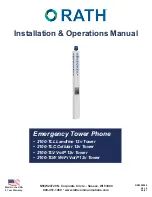
2-6
Cisco Unified Wireless IP Phone 7921G Administration Guide for Cisco Unified Communications Manager Release 7.0
OL-15985-01
Chapter 2 Overview of the VoIP Wireless Network
Understanding WLAN Standards and Technologies
WLANs and Roaming
Wireless IP phones provide communication mobility to users within the WLAN environment. Unlike
cellular phones that have broad coverage, the coverage area for the unified IP phone is smaller;
therefore, phone users frequently roam from one AP to another. To understand some of the limitations
of roaming with wireless IP phones, these examples provide information about the WLAN environment.
•
Pre-call Roaming—A wireless IP phone user powers on the phone in the office, and the phone
associates with the nearby AP. The user leaves the building, moves to another building, and then
places a call. The phone associates with a different AP in order to place the call from the new
location. If the associated AP is within the same Layer 2 VLAN, the IP address remains the same
for the phone. But, if the roaming phone crosses a Layer 3 boundary with DHCP enabled, the phone
recognizes that it is no longer in the same subnet. The phone requests a new IP address before it can
connect to the network and place the call.
Note
If a user leaves the WLAN coverage area and then comes back into the same WLAN area, the
phone must reconnect to the network. By pressing a key on the phone, the user activates the
phone and increases the scanning rate to speed up reconnecting to the network.
•
Mid-call Roaming—A wireless IP phone user is actively engaged in a call and moves from one
building to another. The roaming event occurs when the phone moves into the range of a different
AP, and then the phone authenticates and associates with the new AP. The previous AP hands the
call over to the new AP while maintaining continuous audio connection without user intervention.
As long as the APs are in the same Layer 2 subnet, the unified IP phone keeps the same IP address
and the call continues. As a unified IP phone roams between APs, it must re-authenticate with each
new AP. See the
“Authentication Methods” section on page 2-14
for information about
authentication.
If the unified IP phone user moves from an AP that covers IP Subnet A to an AP that covers IP
Subnet B, the phone no longer has an IP address or gateway that is valid within the new subnet and
the call can disconnect.
•
Layer 3 Roaming—With the release of the Cisco Catalyst 6500 Series Wireless LAN Services
Module (WiSM), the Cisco Unified Wireless IP Phone 7921G now supports Layer 3 roaming for
autonomous mode APs. For details about the Cisco WLSM, refer to the product documentation
available at:
http://www.cisco.com/en/US/products/ps6526/tsd_products_support_model_home.html
Layer 3 roaming with lightweight mode APs is accomplished by controllers that use dynamic
interface tunneling. Clients that roam across controllers and VLANS can keep their IP address when
using the same SSID.
•
Fast and Secure Roaming—Cisco Centralized Key Management (CCKM) enables authenticated
client devices to roam securely from one AP to another without any perceptible delay during
reassociation. With the support of CCKM protocol, the wireless IP phone is able to negotiate the
handoff from one AP to another more easily. During the roaming process, the phone must scan for
the nearby APs, determine which AP can provide the best service, and then reassociate with the new
AP. When implementing stronger authentication methods, such as WPA and EAP, the number of
information exchanges increases and causes more delay during roaming. To avoid additional delays,
use CCKM to manage authentication.
















































